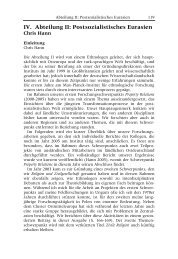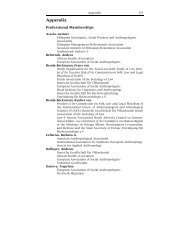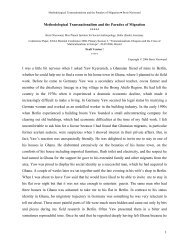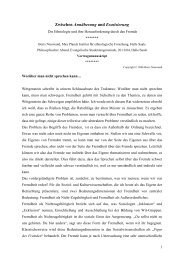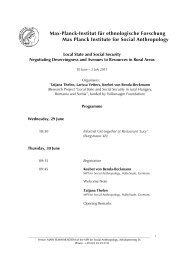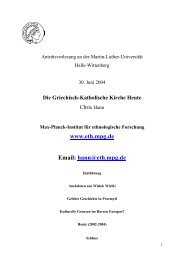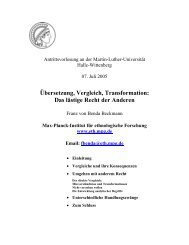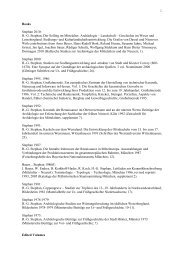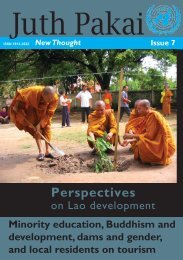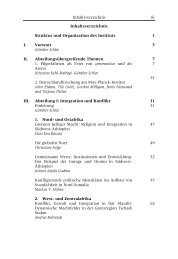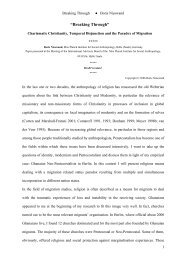ETHNOPOLITICS AND GAbRA ORIGINS - Max-Planck-Institut für ...
ETHNOPOLITICS AND GAbRA ORIGINS - Max-Planck-Institut für ...
ETHNOPOLITICS AND GAbRA ORIGINS - Max-Planck-Institut für ...
Create successful ePaper yourself
Turn your PDF publications into a flip-book with our unique Google optimized e-Paper software.
immutable identities 32 , ethno-nationalists maintain that the identities they proclaim are timehonoured<br />
and ages old. Claims to separate and well-circumscribed ethnic groups or “cultures” of<br />
long standing are rewarded by the international system. UN and NGO driven discourses about<br />
“indigenous” and “autochthonous peoples” favour land rights and resource claims by “peoples”<br />
who can claim a long presence in an area over recent arrivals and groups of recent formation. To<br />
play the “autochthonous” card is therefore tempting, but in the case of the Oromo it leads to absurd<br />
consequences. “Oromo” is a success model. Since the 16th century, the Oromo have expanded<br />
from one end of what now is Ethiopia to the other and beyond. In the course of this expansion<br />
many people joined their fold. One reason of this was that they wanted to avoid the consequences<br />
of ritual warfare many Oromo groups waged against non-Oromo neighbours (and each other), but<br />
to speak of forceful incorporation only does not appear to describe the incentives for becoming<br />
Oromo adequately. There are obvious advantages in belonging to a strong group or alliance 33 and<br />
in speaking a language of wider currency. In the South, the Oromo in question were the Boran 34 ,<br />
and submitting to them was the submission to a power which was hegemonic, I insist, but not<br />
oppressive. The new-comers not only had the lower status but also the privileges of younger<br />
brothers 35 . As a result of these incorporation processes, the majority of the ancestors of those, who<br />
now speak Oromo, did not speak Oromo in the 16th century. The majority of the modern Arsi<br />
Oromo might have spoken Hadiya, and among the Western Oromo (Wollega) there is a saying that<br />
the “Borana” (here in the sense of original Oromo) are one and the gabarti (dependents,<br />
newcomers) are nine. Instead of deriving pride from this success story of incorporation and from<br />
the attraction the Oromo way of life has had for others, modern Oromo nationalists follow the<br />
standard patterns of modern ethnic nationalisms in claiming an immutable ethnic identity and<br />
autochthony. As this view is hard to combine with historical facts, they have to hammer it down<br />
into people’s heads by constant repetition. However, as I have often stressed in my theoretical<br />
writings, identities are not freely invented or fabricated and cannot be changed at will. Sometimes<br />
claims, which are historically absurd, do get accepted by popular opinion. Generally, however,<br />
there is an advantage for identifications which have a degree of plausibility. In the long run,<br />
primordialist claims will not be helpful for Oromo nationalism. The real strength of the Oromo<br />
identity is in its power to combine with other social forces (like Islam in Jimma, Wollo, Bale, Arsi,<br />
Western Wollega, a.o.) and in its potential to assimilate other peoples. And contrary to the<br />
primordialist discourses, a positive identification with these elements of history would also stand<br />
the test of critical historical scrutiny.<br />
32 My own position is that time stability needs to be treated as a variable, not as a dichotomy (like situational<br />
versus primordial), and that it poses an empirical question which needs to be answered case by case. There<br />
are older forms of identification and others which have undergone recent change. Identities change with<br />
different speeds.<br />
33 In the case of the Gabra we have to speak of an alliance. They did not join the Boran but became part of an<br />
alliance of groups which remained separate from the Boran.<br />
34 ‚Oromo’ here is used as a classification by outsiders. The Boran have not used “Oromo” as an ethnonym<br />
for themselves. Only their modern elites were aware of this identification in the 1990s, and its use only<br />
spread to wider circles with the establishment of the new regional order in Ethiopia in the 1990s.<br />
35 Cf. Schlee and Shongolo 1995, where we contest the Gabra claim that they were sexually exploited by the<br />
Boran. It is true that Boran, at the time of the Worr Libin alliance, had access to Gabra women, but likewise<br />
the Boran had no way to tell their own wives not to have Gabra lovers. This form of hospitality or generosity<br />
on the side of the Boran harmonises well with the widespread rule (shared by Boran, Gabra, Rendille) that<br />
the younger brother has access to the wife of his elder brother (and other claims against the elder brother)<br />
while the elder brother, apart from respect and the higher status, can expect little in return.<br />
13



